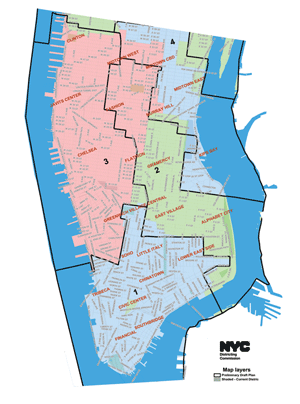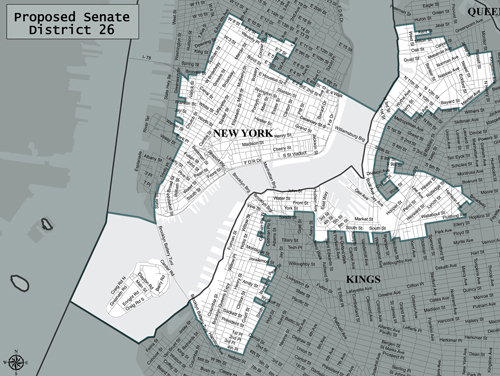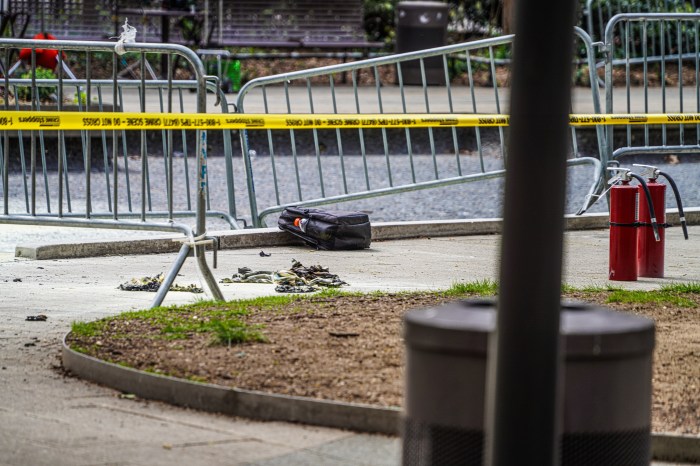
BY LINCOLN ANDERSON | The Districting Commission on Tuesday released preliminary maps for City Council lines, but the results did not go far enough to satisfy advocates who want major changes to Lower Manhattan districts.
At last month’s public hearing before the Districting Commission, some advocates called for a “unified Village” district and others for an Asian-Latino district, while some called for both.
The preliminary map of Council District 3 moves only slightly toward fulfilling the desire for a “unifed Village” district. District 3, currently represented by Chris Quinn, under the new preliminary map, now includes the blocks from Eighth St. to 14th St. between Fifth Ave. and Broadway, which formerly were in District 2.
Meanwhile, contrary to rumors and speculation over the past year that Council District 1, currently represented by Margaret Chin, might lose Soho and N.Y.U.’s South Village superblocks, that hasn’t happened — at least not so far.
Changes to District 1 include the loss to District 2 of a section of blocks east of Broadway and north of Houston St. Also, District 2 has gained part of the Vladeck Houses that was in District 1. That this housing complex formerly was split between Chin’s district and District 2, represented by Rosie Mendez, had been causing some logistical issues.
The biggest change — though not one necessarily demanded by any advocates — was the extension of District 2 up through the E. 20s, 30s and 40s into the Central Business District. This change is to adjust for the big population growth in District 3, particularly in Chelsea, where development has been booming around the High Line.
Every 10 years, Council districts are adjusted to reflect population changes based on Census data. However, district lines must also be drawn so that “protected groups,” including minorities, such as blacks, Latinos and Asians, are able to elect candidates of their choice. Also, the districts must be drawn in such a way as to keep together “communities of interest.”
Another round of public hearings — based on the preliminary draft map — will be held next month. While the current preliminary map reflects population changes, the next part of the process will look more closely at how best to represent communities.
“There are many more views that need to be shared with the commission given the significance of redrawing these lines for the next 10 years,” said Benito Romano, the Districting Commission chairperson. “We encourage the public to participate and look forward to hearing from more of the public in the second round of hearings.”
Added Carl Hum, the commission’s executive director, “We thank the public for attending the first round of hearings. It is only through the public’s participation that the commission will understand how communities are defined and that the next Council lines reflect the needs and diversity of our city.”

As another way of soliciting input, the commission has added a mapping tool on its Web site to allow the public to create a map, draw Council district lines and submit them to the commission.
Asian Americans for Equality expressed support for the preliminary map.
“We appreciate that the commission has preserved most of Districts 1, 2 and 3 in their current form, which will allow opportunities for the Asian, Latino and L.G.BT. communities to elect their own representatives and avoid contentious fights that have recently occurred in other city races,” said Christopher Kui, AAFE’s executive director.
A press release by AAFE added: “The current configuration allows for each major group to keep the integrity of their neighborhoods without pitting the aspirations of the electoral process against each other. The current districts respect the Voting Rights Act and ensure that minority groups are not forced into a zero-sum game where having one representative comes at the expense of the other. This allowed three strong women — a Chinese-American, a staunch advocate of the L.G.B.T. community, and a Puerto Rican — who is also in her own right a champion of the L.G.B.T. community — to represent the core constituents and major pluralities of those districts.”
In a statement, Chin said, “I am confident that the current boundaries of District 1, including the neighborhoods of Tribeca, the Financial District, Chinatown, the Lower East Side, Washington Square Village and parts of Soho, will essentially remain intact as the redistricting process continues.
“Contrary to what some critics want you to believe,” Chin said, “these communities share more in common than they count as differences. Communities of interest are based on more than just skin color. All over Lower Manhattan, affordable housing is disappearing. Luxury development is on the rise and middle-, moderate- and low-income individuals are struggling to stay in their homes on the Lower East Side and in Tribeca.
“School overcrowding is an issue that affects everyone who lives below Houston St., no matter how much money you make,” she continued. “Small business owners — whether it’s a boutique shop in Nolita or a restaurant in Chinatown — struggle to make a profit in an uncertain economy. Traffic, vending and construction are chronic quality-of-life issues that affect every single neighborhood in Lower Manhattan.
“When I look at a map of my district, I see neighborhoods that are united by common bonds — but also common problems. As a diverse district, it is our responsibility to come together with a united voice and use this to advocate for our district and our fair share of resources. If we can do this, I am certain Lower Manhattan will continue to make great strides in the years ahead.”
However, the Asian American Legal Defense and Education Fund — which wants an Asian-Latino district that would include parts of the current Districts 1 and 2 — joined other minority advocacy groups in releasing a citywide “Unity Map” with their preferred district lines that, they contend, reflect the city’s changing demographics. The Unity Map chops Tribeca and Battery Park City out of District 1 and sticks them in District 3; and it extends District 1’s northern boundary all the way across East Houston St. to take in more of the Lower East Side, including the Housing Authority developments along the East River south of Houston St.
“We urge the Districting Commission to adopt the Unity Map in order to meet the requirements of the Voting Rights Act and keep communities of interest together,” said Margaret Fung, AALDEF executive director. “This will ensure that Asian-Americans, blacks and Latinos have fair representation in the New York City Council and can elect candidates of their choice.”
Fung argues that both District 1 and District 2 have been gaining white population, making it less uncertain that District 1 will continue to elect an Asian-American and District 2 a Latino.
Jerry Vattamala, AADEF’s attorney, said there is the possibility of a lawsuit if the city doesn’t heed the call for a Lower Manhattan Asian-Latino district, but Fung said it’s a bit premature to say that at this point.
Jonathan Geballe, president of the Village Independent Democrats club, said he was disappointed that the preliminary map doesn’t go further toward uniting the historic Greenwich Village district.
“It is in the law that communities of interest are supposed to be kept together,” Geballe said. “It’s going to continue this very unfortunate division, if this is adopted.”
Geballe, former Councilmember Carol Greitzer and longtime Village politico Frieda Bradlow support the idea of extending District 3’s eastern boundary to somewhere around the Bowery/Fourth Ave.
Corey Johnson, a candidate for City Council in District 3, said he was glad to see that the preliminary map shows the district retaining Chelsea and Hell’s Kitchen, which, according to the Census, have had an increase in the number of gay couples in relationships. The Census undercounts gays, he said, since only those who are in relationships can indicate their sexuality on the form.
Finally, Andrew Berman, executive director of the Greenwich Village Society of Historic Preservation, wasn’t “districted out” of District 3, since his home in the West 40s is still in the district. He had no update on whether he plans to run for Council, though.

















